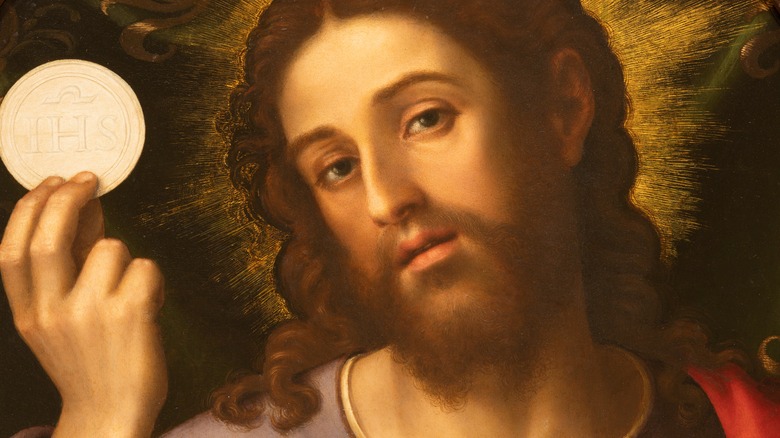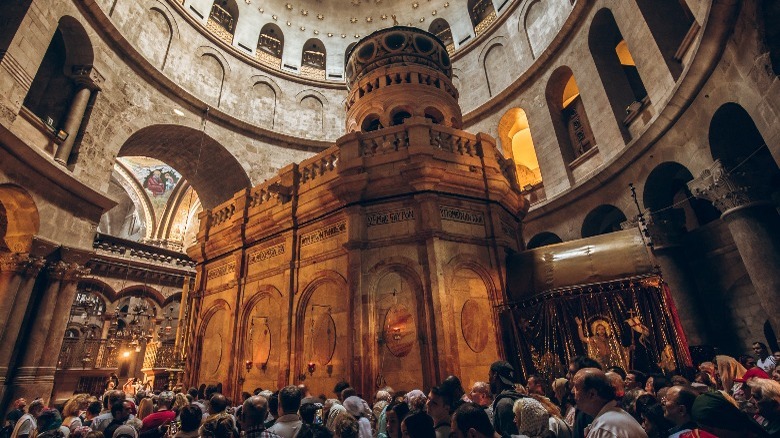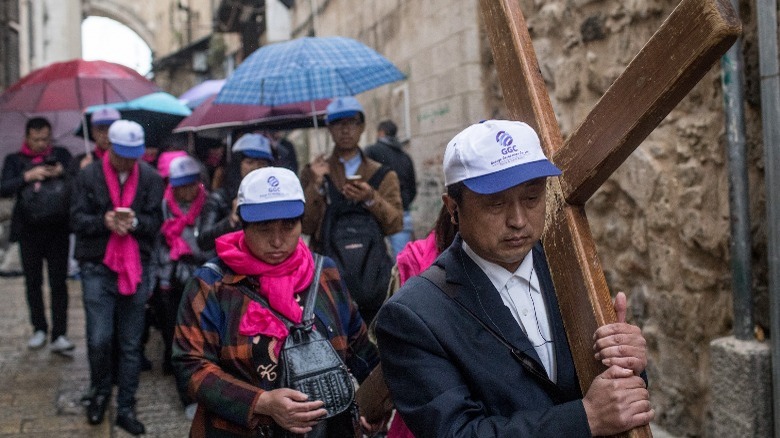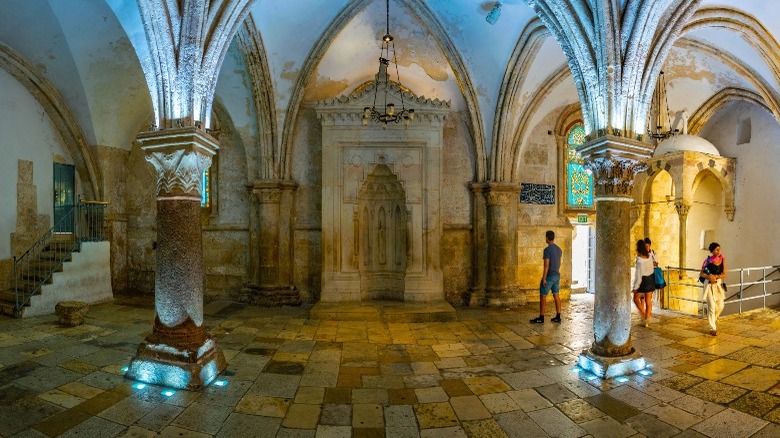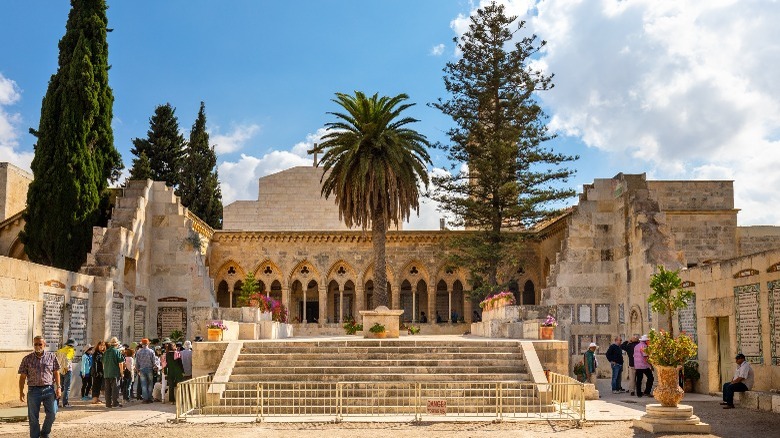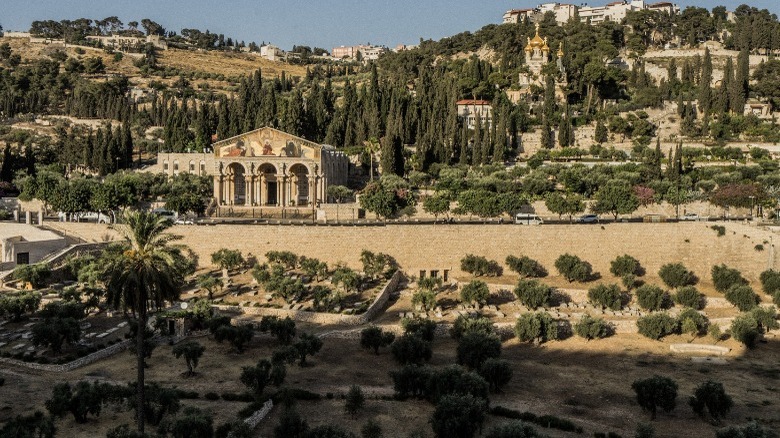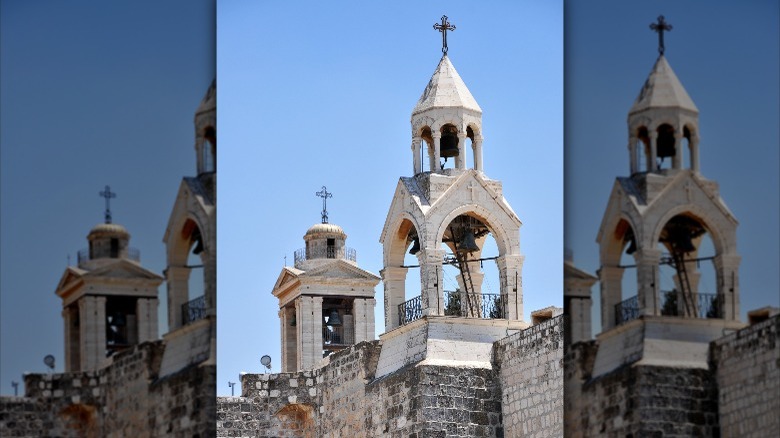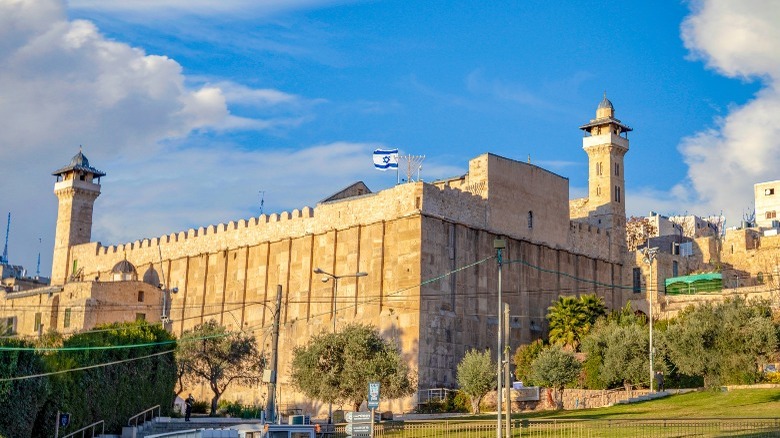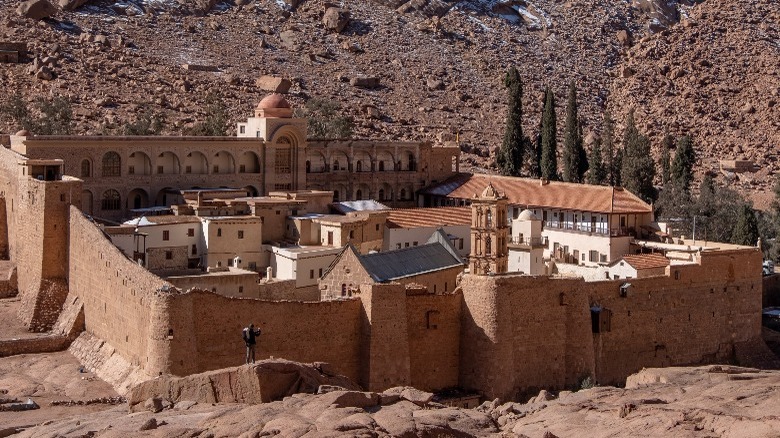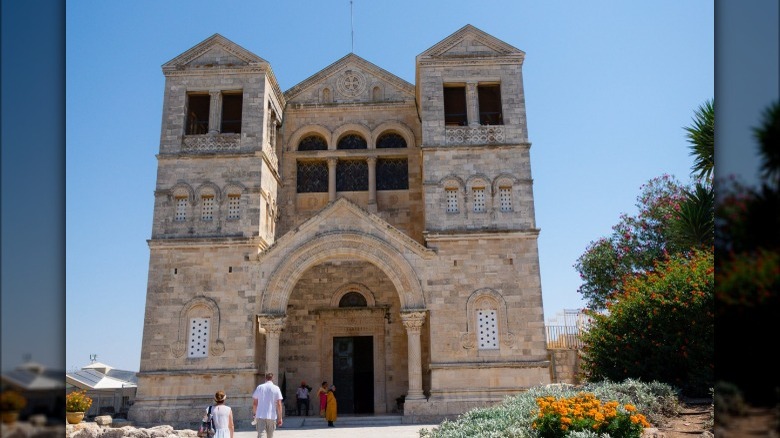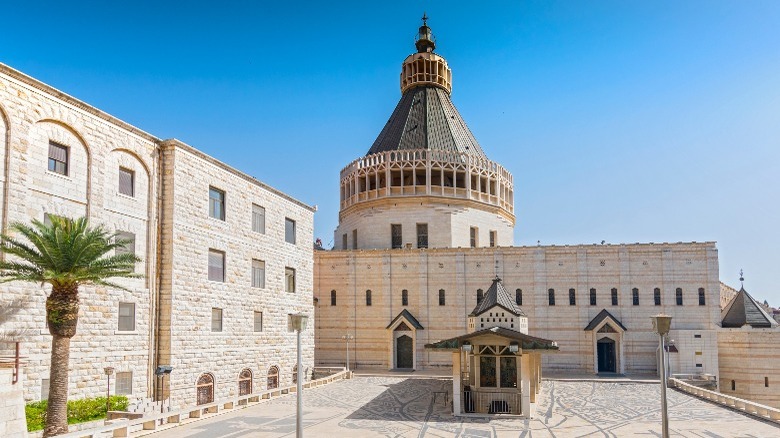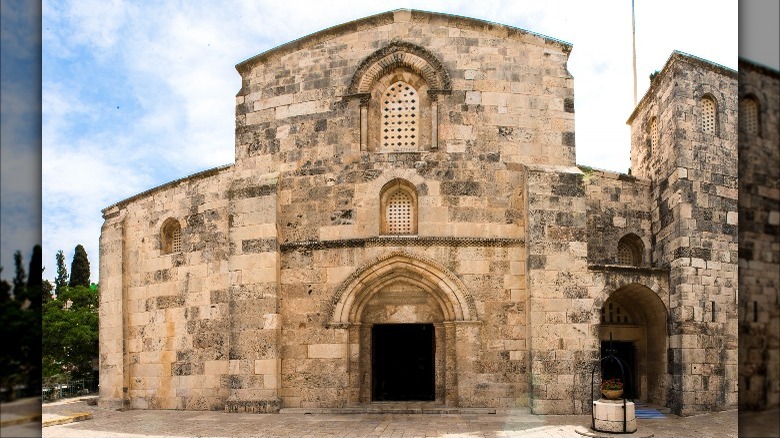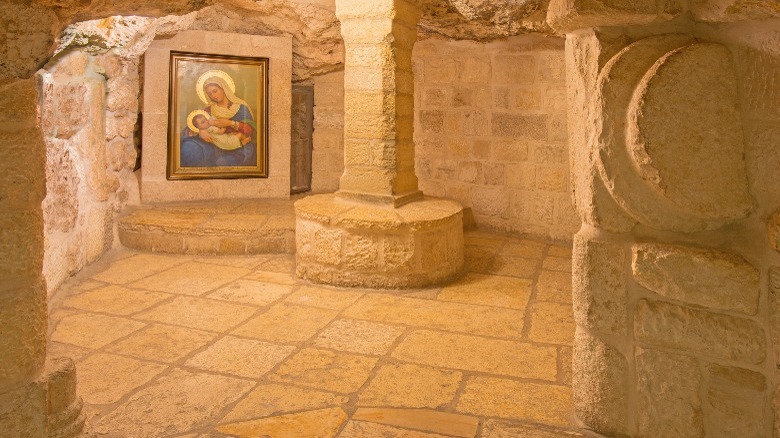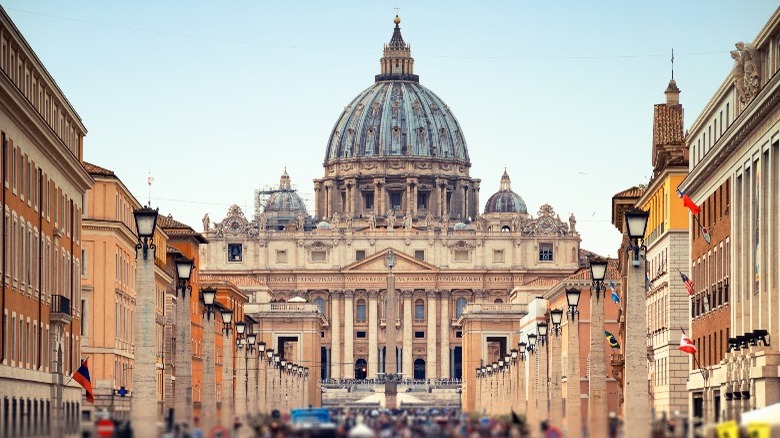The Holiest Sites In Christianity
Among the various Judeo-Christian monotheistic religions, Christianity is by far the most popular worldwide. Centered around the life and teachings of Jesus Christ, Christianity has spread far and wide since its initial beginnings in Israel two millennia ago. There are more than 2 billion followers of Christianity globally, and they are split into three main branches (via History).
The three main branches of Christianity are Catholicism, Protestantism, and Eastern Orthodox. There are also nearly 20 smaller denominations that make up Protestantism, including Baptist, Methodist, Evangelist, and Presbyterian. The central religious text of Christianity is the Holy Bible, which is split into two parts: the Old Testament and the New Testament. The testaments consist of more than 60 books combined, and there are several different versions of the bible. The most widely read version of the bible is known as the King James Bible, which dates back to the 17th century (via Cambridge University).
Due to its founding in the ancient Middle East, many of Christianity's most sacred sites are located in Israel and Palestine. There are also important spots in Egypt, and Rome is highly significant for Catholics. These are the holiest sites in Christianity.
The Church of the Holy Sepulcher
One of the most sacred and important sites in all of Christianity is the Church of the Holy Sepulcher. According to Britannica, the Church of the Holy Sepulcher is so important because it is considered the place where Jesus Christ was crucified and buried. Located in the Old City of Jerusalem in Israel, the church consists of several important shrines. These include the Rock of the Cavalry, the Altar of Crucifixion, and Jesus' tomb, which is called the Edicule.
Though Jesus died in the first century, it wasn't until the Roman Emperor Constantine built a church on the site in the 4th century that it was officially recognized as the site of Jesus' crucifixion. Archaeological dating puts the original church at about the year 345, though there is very little of it remaining still today. The original church was destroyed several centuries after it was built, and it has been rebuilt and remodeled extensively over the past thousand years.
The church is built on Golgotha hill, though it's unclear if the current church is located on the actual site of Jesus' death. Centuries of upheaval and change in Israel and Jerusalem largely forced Christians out of the city for a time, and the specific identification of many places was unfortunately lost to history.
The Via Dolorosa route
Though it's not a single solitary place, the Via Dolorosa is another of the most significant and important routes in all of Christianity. As the "The Oxford Dictionary of the Christian Church" explains, the Via Dolorosa is said to be the path that Jesus took during his walk to be crucified. The route stops at Mount Calvary, which is where the Church of the Holy Sepulcher is found, and there are said to be 14 "Stations of the Cross," which are specific places around the route that pilgrims find significant. According to tradition, Franciscans in Jerusalem recreate the route ritualistically on Fridays.
According to "Pilgrimage: From the Ganges to Graceland: An Encyclopedia," the route starts at the present-day location of the Al'Omariyeh college, which is the former site of the Chapel of the Crowning With Thorns. Along the route are stops that include where Jesus was given the cross, the various spots where he fell, and the areas where he met Mary, Veronica, and the woman of Jerusalem.
People frequently travel to Jerusalem to commemorate Jesus' walk every year, and some of them even carry large wooden crosses with them. The Via Dolorosa is reenacted and commemorated at churches throughout the world, especially within Roman Catholic institutions.
The Cenaculum
Many of the spots that are significant in the bible are considered holy places by Christians, including the building where the Last Supper is said to have been held. Known as the Cenaculum or Cenacle, which means "upper room," it is now a church located on the holy Mount Zion in Jerusalem (per "The Oxford Dictionary of the Christian Church"). Not only is it said to be the site of the Last Supper, but tradition also holds that it is the spot where the Pentecost happened.
During the second century, the first church on the site was built, and it is also the site of the Jewish patriarch King David's tomb. According to Jerome Murphy-O'Connor in "The Holy Land: An Oxford Archaeological Guide from Earliest Times to 1700," the current construction of the Cenaculum dates to the fourth century, though it was heavily restored by Franciscans in the 12th century after several fires. The church was originally called "The Upper Church of the Apostles," before being changed to its current name, "Zion, Mother of all the Churches."
Murphy-O'Connor claims that though tradition holds the Cenaculum as the spot of the Pentecost and Last Supper, the evidence to support the Last Supper happening there is dubious. He argues the site was likely merged with the Pentecost on Mount Zion due to them both occurring in the "upper room," which was assumed to mean the same thing.
The Church of Pater Noster and Chapel of Ascension
One of the most dominating physical features in Jerusalem is the Mount of Olives, and to go along with its imposing physical stature is the mountain's incredible historical significance. As Faith Notre Dame explains, one of the many important sites located on the Mount of Olives is the Church of Pater Noster. The Pater Noster Church is believed to be built on the spot of an ancient cave where Jesus used to teach his disciples. It was identified as such by St. Helen (Constantine's mother) in the fourth century, when she immediately had a church erected.
In addition to teaching disciples at the cave, it was also a place where Jesus used to pray himself. It is a common site for Christians to visit in Jerusalem today, where many of them gather to pray and feel connected with Jesus.
Right next to the Pater Noster Church is the former Chapel of the Ascension, which was also located on the mountain. The chapel was said to be built on the place where Jesus ascended to heaven after his resurrection. The chapel was commissioned by St. Helen as a tiny open-roofed building. It was later destroyed and rebuilt into a mosque -– which it currently is now.
Gethsemane and the Church of All Nations
Another important site related to ancient Christianity located on the Mount of Olives in Jerusalem is the Garden of Gethsemane. According to Jerome Murphy-O'Connor in "The Holy Land: An Oxford Archaeological Guide from the Earliest Times to 1700," Jesus traveled to the Gethsemane following his Passover meal known as the Last Supper. As it is written in the Gospel of Matthew, Jesus goes to the garden with three of his apostles, including Peter, where he prays to god while emotionally stricken (via Bible.com). During his time in the garden, Jesus falls down, and the entire event is known to Christians colloquially as the Agony in the Garden.
Immediately following the Agony in the Garden, Jesus gets arrested and is ordered crucified, making the event in the Garden highly significant and sacred for Christians. In 1924, a church was erected on the spot where it is thought that Jesus fell down. It is called the "Church of All Nations," and it's located on the path between the Last Supper and the top of the Mount of Olives. Though the authenticity of the site as the biblical site of the Gethsemane cannot be completely confirmed, it is widely accepted as the area today.
The Church of the Nativity
For many Christians, Bethlehem is one of the holiest cities in the entire world, and the connection mainly lies with it being the town where Jesus was said to have been born. The spot where Jesus was born is thought to be a cave in Bethlehem, upon which now sits the Church of the Nativity, and it is probably the most sacred spot in the entire city (via UNESCO). The church became associated with the spot of Jesus' birth around the second century, and the first temple was erected a short time after in the fourth century.
The present church's construction dates all the way back to 533, and it is currently administered by the Greek Orthodox Church, the Custody of the Holy Land, and the Armenian Church. There are still parts of the original church visible, and it has been a frequent place of Christian pilgrimage since the fourth century.
Unfortunately, the site's increasing age is starting to catch up with it, as parts of the church are beginning to lose structural integrity (per the Smithsonian). Tensions between clerics from the three different administrators have handicapped repairs for years, but there is hope the temple can be restored to its former glory. Still, the spot is very popular today among Christians and is highly sacred within the religion.
Cave of the Patriarchs
Another important city in Israel with Christian holy places is the Old City of Hebron. As "Pilgrimage: From the Ganges to Graceland: An Encyclopedia" explains, Hebron is located just south of Jerusalem and is an incredibly holy city within Judaism –- the predecessor to Christianity. In the biblical book of Genesis, the Cave of Patriarchs in Hebron is identified as the resting place of Abraham, and he is said to be buried there along with his sons Isaac, and Jacob, as well as their wives Sarah, Rebecca, and Leah. This cave is also known by the name Machpelah, which means double in Hebrew, and is likely a reference to the couples being buried together.
Not only is the site associated with Abraham and his direct lineage, but it is also linked with Adam and Eve and Moses –- all important figures in the Christian Bible. According to the bible, Abraham bought the cave when he arrived in Hebron after making it his new home (via "The Oxford Dictionary of the Christian Church"). The mighty Jewish King David also ruled the independent Kingdom of Hebron, until he merged it with Jerusalem. Some Christians connect the cave with Jesus' mother, the Virgin Mary, claiming she has divinely visited it.
Mount Sinai and St. Catherine's Monastery
One of the most important places in the bible is the holy Mount Sinai in Egypt, and unsurprisingly it is a frequent place of Christian pilgrimage today. As per Britannica, Mount Sinai is located on the Sinai Peninsula in Egypt, on the present-day Mount Horeb (also known as Mount Hareh). Christians believe that Sinai is the spot God revealed himself to the patriarch Moses and gave him the Ten Commandments and the Tanakh. Not only is the mountain important for Christians, but Muslims and Jews also revere the mountain due to its association with Moses and the biblical burning bush story.
In the fifth century, the Roman Byzantine Emperor Justinian built St. Catherine's Monastery on Mount Sinai. There are a maximum of 36 monks living in the monastery at any one time, and it is of the Eastern Orthodox denomination. Much of the original structure has actually been pretty well secured, and it has been a site of Christian pilgrimage since at least the Middle Ages. It is a UNESCO World Heritage site, and the oldest Christian monastery still in use (per UNESCO).
Mount Tabor
Located in the Lower Galilee region in northern Israel near Nazareth, Mount Tabor has an important biblical association with both the New and Old Testaments. It is specifically named in the Old Testament as the place where Israelite warrior Barak defeated the Canaanite Sisera in the 11th Century B.C.E. (via Britannica). In the New Testament, it is commonly associated with the story of Jesus' miracle of transfiguration.
According to the bible, the transfiguration occurred when Jesus started radiating incredibly bright white light at his disciples Peter, John, and James while they were praying on a hill. It is also associated with the revelation of the divinity of Jesus, one of the three persons of the Trinity.
The transfiguration was an incredibly important part of the life of Jesus, and it is commemorated annually by the Feast of the Transfiguration among Catholics and the Eastern Orthodox. As Faith Notre Dame explains, Mount Tabor began to be associated with the transfiguration starting in the third century. Today, it is a common place for Christians to visit, and at the summit of the mountain lies the Church of the Transfiguration, which commemorates the miracle.
The Church of the Annunciation
The city of Nazareth in Israel is another holy city for Christians, and within it, the Church or Basilica of Annunciation is one of the most sacred sites. According to Faith Notre Dame, the Gospel of Luke cites Nazareth as the location of Jesus' parents' residence prior to his birth. While they were living in Nazareth, the bible says that God's angel Gabriel visited Mary and delivered God's message asking her to bear his only son. The spot Gabriel appeared is known today as the Grotto of Annunciation, and it is within the present-day church (via Britannica).
There is evidence of an initial church structure from the fourth century, and there was a much more extensive one built in the 18th century. Today, the church is the largest in the Middle East, and its current construction dates back to the 1950s-'60s.
Other churches have been built in the area throughout history, but they were all destroyed during various points of Muslim rule (via the Jewish Virtual Library). Pilgrimages resumed during the medieval Crusader period when the area came under Christian rule but was again revoked under Mamluk rule. Since the mid-17th century, there has been Christian access again, and it is a very popular spot for pilgrims today.
The Church of St. Anne
The Church of St. Anne in Jerusalem is another incredibly holy site in Christianity. As Faith Notre Dame explains, the present-day church is believed to be placed on the spot where Jesus' grandparents, Joachim and Anne, once lived. It is also said to be the place where Mary, Jesus' mother, was born. Inside the church is a white stone statue of St. Anne with a young Mary by her side. The church is located very close to the sacred Temple Mount, which is another incredibly important spot in Christianity.
Also near the spot are the Bethesda pools, which are said to be where one of the miracles of Jesus' healing took place when he cured man's illness of 38 years. The original church, which had been built sometime in the fourth century, was destroyed in the 7th century by Persians, but a new one was built on the same spot in 1138 (via Jerome Murphy-O'Connor in "The Holy Land: An Oxford Guide from the Earliest Times to 1700"). It was connected to the famous City of David in the eighth century via a waterway, and French missionary priests are the church's current administrators.
The Milk Grotto cave
The Milk Grotto in Bethlehem is another one of the holiest sites in Christianity. According to "Pilgrimage: From the Ganges to Graceland: An Encyclopedia," the grotto is a small cave near the Church of Nativity that is important for its connection with Jesus' mother Mary. The cave is all white, which is said to represent Mary's milk, and some very religious parents try to mix the milk with their baby's food. The milk is believed to have healing powers, including helping to cure infertility (via the BBC).
During the Massacre of Innocents, which took place amidst the violent King Herod the Great's reign, Mary and Jesus entered the cave to escape the bloodshed. One of the drops of Mary's milk touched the stone floor, instantly transforming it to white. Today, both Christian and Muslim mothers and prospective mothers from around the world travel to the Milk Grotto in hopes of securing some of Mary's milk. Some people even bring back the powder to friends and relatives at home, claiming it has helped them to have children.
In the fifth century, a church was first erected on the site by the Byzantines (per the City of Bethlehem). The current chapel dates back to the 19th century and is open daily for worshippers to pray at.
Vatican City
Not all of the holiest spots in Christianity are in the Middle East, and in fact, one of the holiest places for Catholics is Vatican City in Rome, Italy. The city is home to many incredibly sacred and holy Catholic sites, including St. Peter's Basilica, the Vatican Palace, the Sistine Chapel, and the Vatican Museums and Galleries (per Britannica). The Sistine Chapel was built in the 15th century and features world-renowned frescoes painted by Michelangelo.
The most significant building is St. Peter's Basilica, which houses the remains of Jesus' apostle, St. Peter. Rebuilt in the 16th century during the Renaissance, it is the largest Christian religious building in all of Europe and Asia. Some of the most important Roman architects in history helped build the basilica, including Raphael and Michelangelo. It houses incredible amounts of holy Catholic relics and is a constant spot of Catholic pilgrimage year-round. There are just shy of 100 former popes buried in the basilica, including the first pope, St. Peter.
Since 1929, the Holy See has been located in Vatican City, making it the worldwide center for Catholicism. Though it's located within Rome, the Vatican is a completely autonomous area that is under the sovereignty of the Pope. Most of the city is inhabited by clergy members, though it is an incredible site for international tourism.
